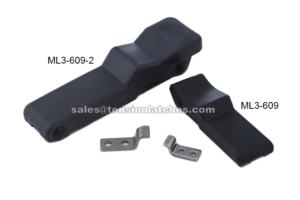Tension Lever Locking Latches are a safe locking system for industrial applications. They can take up high tensile loads. Lateral forces must be kept off the tension latch by the design of the parts linked with each other. Most of the tension latches can be adjusted by a reverse offset draw hook. For fixed series, a spring-steel draw hook serves for tolerance compensation. For increased vibration resistance, many tension latches are also available with secondary locking mechanism.
Tension Lever Locking Latches are referred to as a “draw latch” because it forcibly draws together the two closure members on which the latch members are mounted. Such members may be components of a cabinet, or a case, or a housing for a machine, a window or door panel, or any type of enclosure.
In many cases, the closure members will be co-planar panels, but, in other cases, the two closure members will be angularly disposed of, such as at right angles to each other.
All draw latches are basically toggle devices having three links and three pivot points. The prior art has provided draw latches of the toggle type with means for adjusting the distance between latching points.
Some prior art Adjustable Tension Latches incorporate a screw thread in the link which is to be stressed in tension. This introduces an undesirable feature, namely, if the latch is loaded beyond its maximum holding strength, there would be a complete failure of the latch mechanism.
ALSO OF INTEREST: Toggle Style Draw Latches ML3-617 tension latch assembly Spring Loaded Toggle Latch Hasp ML3-605




